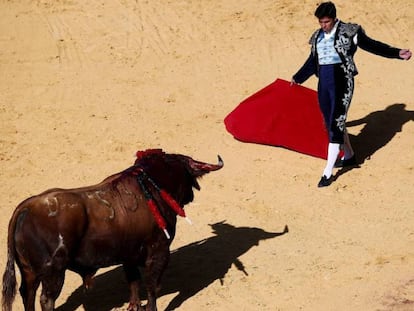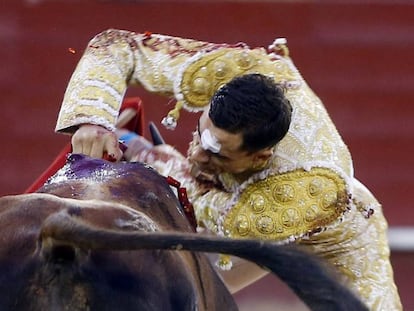The bullfighting class of 2018
Dozens of boys want to be matadors nowadays and are pouring into specialized academies to learn how to survive in the arena
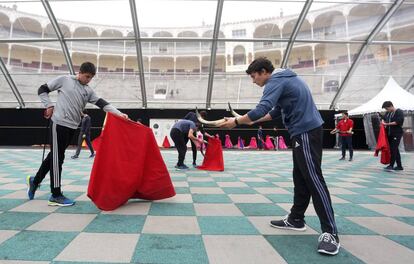

The boys start arriving at the academy at 5pm. One by one, they approach their track-suited teacher, shake his hand and say, “Good afternoon, teacher.” This polite greeting is part of the training in “respect and traditional values” offered at the José Cubrero “Yiyo” bullfighting school, run by bullfighter José Pedro Prado, who is popularly known as “El Fundi.”
The daily classes take place in the Las Ventas bullring in Madrid. It may seem like aminor detail, but it is in fact central to the school’s success, and responsible, according to those in charge, for the steady increase in student numbers.
I know I am missing out on my teenage years. I don’t go out at all, but what makes me happy is bullfighting Villita, 17-year-old student
Las Ventas has been home to Spain’s most revered matadors. Now, for €20 a month coupled with unequivocal commitment, a youngster of either sex can be schooled in the technique of simulated bullfighting until ready to take on young steers. Once they have graduated to the real thing, other costs come into play, such as €300 for capes and over €1,000 for swords, not to mention the cost of a small-scale bullfight, known as novillada. One might think that in this era of screens and devices, there would be few takers. But, as early 20th century bullfighter El Gallo, otherwise known as Rafael Gómez Ortega, might say, there are people for everything.
These young aspirants are not so different from bullfighting wannabes of 20 years ago, but they are different from the plucky youths who once threw themselves in front of the bulls in the local village square, looking for an opportunity to show off their skills; and from those who, stealing into a field of fighting bulls, would have their act of bravado end in tragedy. Now, they all go to school to learn the tricks of the trade and claim to understand that fame and fortune, if it comes their way, won’t be theirs for long. “With luck, a career will last eight to 10 years,” says former bullfighter Miguel Rodríguez. Still, it is hard to persuade these young hopefuls that there won’t be a gilded future awaiting them in the arena, all be it a brief one.
The students are predominantly from modest backgrounds – from either lower-middle class or middle class families. And they are prepared to work hard. Recently, the physical training element of the program has been intensified so that students are in good shape before moving into more specific terrain. They are also mainly from families with bullfighting in their blood. The father of Juan José Villa actually donned the sequined suit as a banderillero – the person who sticks multi-colored darts into the bull’s neck – as was Borja Ximelis’ grandfather. Ximelis’ great-grandfather, meanwhile, took on some of the biggest bulls in the ring. Needless to say, almost all have a mother who is less than enthusiastic about their child’s ambition.
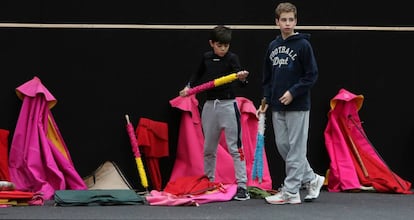
Every afternoon, 17-year-old Villita takes a bus from his hometown of Manzaneque in the province of Toledo to Madrid, returning by the same means of transport late at night, and eating a sandwich on the way. Villita studies cooking at a higher education college in case his bullfighting ambitions are derailed. In this event, he will prepare dishes in his father’s restaurant.
Villita’s classes leave little time for anything else, other than seeing his family on Sundays and rest. “I know I am missing out on my teenage years,” he says. “I don’t go out at all. But I am gaining in ways that are better in the long run. You have to do what makes you happy and what makes me happy is bullfighting.”
Many believe that the new political parties will fail to take bullfighting into account
There are 50 bullfighting academies in Spain, and 10 more across France, Mexico, Portugal and Colombia. Altogether, these academies have 1,200 students. Most are private but around 10% receive subsidies, usually from the local or city council. Madrid's Mayor Manuela Carmena cut the city council's €61,200 annual subsidy to Madrid’s famous Lalanda bullfighting school in 2015. “Andalusia is the only region that openly sets aside €100,000 of its budget,” says Eduardo Ordóñez, president of the region’s bullfighting federation that has 24 academies and 430 students under its umbrella this year. “The future of these academies is in the hands of the politicians,” says Óscar Plaza, who is setting up an international association of academies. Many believe that the “new political parties” will fail to address their needs.
There is no data on how the academies have evolved in recent years. Nor is it clear how many students they have. What is clear is that the public has lost a certain degree of interest in this peculiarly Spanish ‘art’. According to figures from the Ministry of Culture, the number of bull runs in the provinces, accounting for a quarter of all bullfighting spectacles, fell from 953 to 387 between 2007 and 2016. In 2006, 9.8% of the population went to see a bullfight, but in 2015, this fell to 6.9%. “Before, young guys only looked up to [soccer player Afredo] Di Stéfano or ‘El Cordobés’,” says Rodríguez. Today, soccer players have mostly taken the lead.
Borja Ximelis looks more like modern matador Francisco Rivera Ordóñez than the bullfighters of yesteryear. He is sweating profusely from his afternoon workout at Las Ventas. At 20 years old, he is about to make his debut in the ring. This summer he will take on two young steers.The minimum age to fight in the bull ring is 16 but does not include picadors – a person who goads the bull with a lance. Performing trial runs at the academy, which organizes bullfights and exchanges across Spain, can begin at 14.
The female fighter
Bullfighting schools are no longer just about simulating the bullfight and physical exercise. The pupils at Las Ventas now receive classes in the theory of the sport, as if to school them in politically correct responses to critics of the ‘art’. At times, the youngsters appear to be merely spouting what they have learned; formatted answers engineered to align with today’s prevalent attitudes on the issue. When it comes to female bullfighters, for example, Villita, a 17-year-old student, says, “It doesn’t matter if it’s a man or a woman. There’s a girl here and we get on very well with her. She is treated as a complete equal by us; women are important in bullfighting and I would also encourage them to come and see the spectacle. It’s for everyone.”
The man in charge of the school, Miguel Serrano, is from Seville. He believes that it is more likely for a girl’s family to dissuade her from the arena than for a boy’s. “Girls have a look that fits with the spectacle, but bravery is also important,” he says. “Decisiveness and strength also count.”
One glance at the academies’ books says it all. There are few girls – one per academy at most. The last figures published by the Ministry of Culture show that women account for just 2.6% of professional bullfighters.
“Bullfighting is like a poison you can’t live without,” says Ximelis. “It’s a good drug.” He ventured into the local bullring at the age of seven at his cousin’s communion and has been addicted ever since. He complains of a general ignorance regarding the bullfighting world and of the anti-monarchy and anti-bullfighting lobbies. “If you like bullfighting, you get called a fascist and now, it seems, the example to follow is anti-fascist.”
Rodríguez and Miguel Serrano believe the flack their students have to deal with helps them to mature. Naturally some deal with it better than others while there are those that seem immune. As far as Mexican Jaime Portilla, 17, is concerned, he could not care less what people say. Portilla hails from a family with no interest in or connections with bullfighting. Nevertheless, he decided this was his path in life and moved to Spain where he lives frugally to pursue his dream. “I am not personally criticized, not even at high school, because a bullfighter studied there,” he says smiling.
It is impossible to measure the general sentiment towards bullfighting but it is certainly not as positive as it was in the era of Manuel Benítez Pérez, better known as “El Cordobés”, who was an icon of the ring in the 1960s. And the academies know that they have a challenging future ahead.
So what are the reputed bullfighters doing to keep the tradition alive? “Nothing,” says Eduardo Ordóñez. “I have personally approached famous bullfighters who have come out of our academies to ask for support and have got nowhere. It’s very sad.” There are exceptions, however, such as Espartaco or El Juli; but not many.
Television is another of the pillars needed to keep bullfighting in the public eye. “It’s very important,” says Ordóñez. “Chanel Sur reruns 10 bullfights.”
Then there are the young students who are also playing their part. Óscar Lapuente, 12, is the youngest at the Madrid academy this year and also had a banderillero in his family. Now he has no time for tablets and video games or even soccer. For him bullfighting is both his passion and his refuge, what El Gallo might interpret as the glory of taking the bull’s ear as a trophy.
And there’s Villitas, who at the end of September, entered the Zapato de Oro contest in Arnedo, La Rioja, along with three colleagues, having been selected from dozens of hopefuls. There is a sense of destiny here. Of God’s will at work, for few at Las Ventas are atheists, according to Ximelis. “The world of bullfighting is about strength and sacrifice. Luck is no more than preparation,” he says. “But you have to have something to hide your fear behind.”
A more uniform approach to the arena
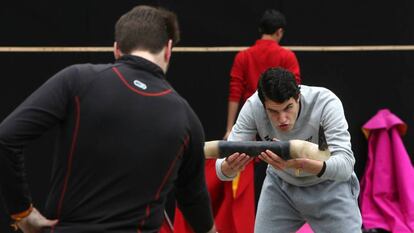
The time when a bold youth and a posse of lads at his heels set out for the local field of fighting bulls in order to show off is long gone. So too is the era of spontaneous bravado in the local bullrings with youths running ahead of the Civil Guard.
Those antics, particular to the 1970s, have been replaced by formal lessons in bullfighting schools. And those eager to take on the bull now formally learn how to wield the various styles of cape and other tools of the trade as they are initiated into this tough but glorious world. But, above all else, they are schooled in values, such as sacrifice, strength and compromise. For many this is what they will take away, as the dream is often impossible.
Few actual bullfighters emerge from these academies. And connoisseurs of the ‘art’ complain those who do lack personality as they follow a uniform style.
Becoming a bullfighting icon is almost as hard as becoming the Pope and only a very few break the mold and taste the glory of the ring. For those who don’t, there’s the consolation of having learned something of the art of living.
English version by Heather Galloway.
Tu suscripción se está usando en otro dispositivo
¿Quieres añadir otro usuario a tu suscripción?
Si continúas leyendo en este dispositivo, no se podrá leer en el otro.
FlechaTu suscripción se está usando en otro dispositivo y solo puedes acceder a EL PAÍS desde un dispositivo a la vez.
Si quieres compartir tu cuenta, cambia tu suscripción a la modalidad Premium, así podrás añadir otro usuario. Cada uno accederá con su propia cuenta de email, lo que os permitirá personalizar vuestra experiencia en EL PAÍS.
¿Tienes una suscripción de empresa? Accede aquí para contratar más cuentas.
En el caso de no saber quién está usando tu cuenta, te recomendamos cambiar tu contraseña aquí.
Si decides continuar compartiendo tu cuenta, este mensaje se mostrará en tu dispositivo y en el de la otra persona que está usando tu cuenta de forma indefinida, afectando a tu experiencia de lectura. Puedes consultar aquí los términos y condiciones de la suscripción digital.
More information
Archived In
Últimas noticias
Maduro pleads not guilty before the federal court in New York: ‘I am still the president of Venezuela’
A new test can detect Alzheimer’s from a finger prick
UN team enters Sudanese city of El Fasher after paramilitary massacre: ‘It’s like a ghost town’
A recipe for resistance: Indigenous peoples politicize their struggles from the kitchen
Most viewed
- Gilles Lipovetsky: ‘If you want to live better and fall in love, take Prozac, don’t look to philosophy’
- Alain Aspect, Nobel laureate in physics: ‘Einstein was so smart that he would have had to recognize quantum entanglement’
- Maduro’s downfall puts China’s relationship with Venezuela to the test
- Why oil has been at the center of Venezuela-US conflicts for decades
- Alvin Hellerstein, a 92-year-old judge appointed by Bill Clinton, to preside over Maduro’s trial in New York
